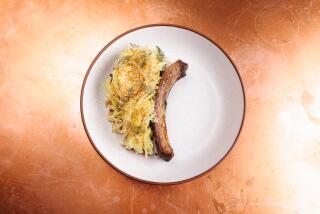Simmering Symphony
- Share via
We usually think of meat standing alone--a roast, a steak, even most stews, for example. But when it comes to many hearty winter dishes, the more meats, the merrier.
That’s not referring to quantity but to variety. All meats are not the same, after all. Beef tastes much different from pork or lamb and, though veal has hardly any flavor, it does have a really nice moist texture.
By combining various meats in the same dish, you can take advantage of their individual strengths and minimize their weaknesses.
Use a little orchestral imagery: Think of beef as being the cello, round and deep. Pork is the violin, sweet and higher in tone. Veal? That’s the forgotten one, the accompanist, tinkling away in the background, barely noticeable but somehow the thing that holds the dish together.
Combine them and you’ve got something more than the sum of its parts; you’ve got a symphony . . . or a sausage (or a meatloaf, a stew or a pasta sauce).
Just as in music, there’s no magic formula: The ratio of one meat to another will vary depending on the result you want. In meatloaf, for example, I like a combination of half beef, a quarter pork and a quarter veal. That gives the combination of flavor, sweetness and succulence I’m looking for. For a pasta sauce, I might want more pork than beef.
You can even get a marvelous depth of flavor just by using different cuts of pork, particularly if at least one is sweet sausage. There’s a great winter stew made by braising cabbage with country-style pork ribs, fennel sausage and pancetta or bacon.
One key to these dishes is browning the meat very deeply. You don’t want to scorch it, of course, but you do want to get it to that light mahogany stage (with ground meats, even darker).
Browning develops a whole series of flavors that plain boiled meat lacks. These are the tastes you get from the Maillard reaction, a range of flavors caused by the heating of amino acids and natural sugars that was named after an otherwise forgettable Frenchman.
The important thing to remember about the Maillard reaction is that it doesn’t begin until the temperature has passed 300 degrees. That means that all moisture must be gone (the temperature won’t go past the boiling point--212 degrees--as long as there is liquid present). Pat the meat dry with a paper towel before beginning to brown it.
Although a rather high temperature is required, browning is best accomplished over moderate heat. That reduces the risks of scorching; the meat will brown slowly and evenly. Also, browning over too-high heat can toughen meat, even if it is to be braised with liquid afterward.
Finally, don’t be impatient. Let the meat rest in the pan. It takes contact with the metal to develop the high temperatures needed for browning, and if you’re always stirring the meat, it’ll keep cooling off. Just leave it alone and it’ll do nicely with only occasional attention.
This recipe is one of those dishes for a rainy Sunday afternoon. The earthiness of the lentils is perfectly accented by the deeply browned meats. At the same time, the splash of vinegar and the crushed tomatoes lend a piquancy that keeps all those dark, rumbling flavors from getting overpowering.
The final addition of the shredded cabbage should melt into the soup, adding a green sweetness. Don’t overcook it, or it will turn sulfury and nasty.
On the other hand, like so many dishes of this type, this soup improves on overnight storage and a gentle reheating. If you’re making it even a couple of hours in advance, refrigerate it and then warm it up before serving it rather than leave it on the stove.
There’s nothing worse than an overheated orchestra.
Lentil Soup
Active Work Time: 25 minutes. Total Preparation Time: 1 1/2 hours
2 tablespoons olive oil
1/2 pound Italian sausage
1/2 pound beef stew meat
1/4 cup red wine vinegar
1 onion, chopped
2 carrots, chopped
2 stalks celery, chopped
3 cloves garlic, chopped
1 pound lentils
10 cups water
1 bay leaf
1 (28-ounce) can crushed tomatoes
Salt
1 pound cabbage
Freshly ground black pepper
* Heat oil in large, heavy soup pot over medium heat. Crumble sausages from casing into pot and break up with spoon. Chop stew meat as fine as possible by hand and add to soup pot. Cook, stirring occasionally, until meats are dark brown, about 15 minutes, but do not scorch.
* Add vinegar and stir. Vinegar will evaporate almost immediately. Using slotted spoon, transfer meat to strainer and shake to remove as much grease as possible. Discard all but 1 tablespoon grease in pot.
* While meat is draining, add onion, carrots and celery to pot and return to medium heat. Cook, stirring frequently, until vegetables have softened and become fragrant, about 5 minutes. Add garlic and cook 2 to 3 minutes more.
* Add lentils and stir to coat with flavorings. Add meat, water, bay leaf, tomatoes and 1 teaspoon salt and bring to simmer. Cook at simmer 45 minutes, until lentils have softened.
* Cut cabbage in quarters. Trim out core and shred cabbage coarsely. About 15 minutes before serving, add cabbage to pot and stir to mix well. Let cabbage melt into pot, then season to taste with a good grinding of black pepper and more salt and vinegar if necessary.
8 to 10 servings. Each of 10 servings: 299 calories; 318 mg sodium; 23 mg cholesterol; 9 grams fat; 36 grams carbohydrates; 21 grams protein; 3.41 grams fiber.



